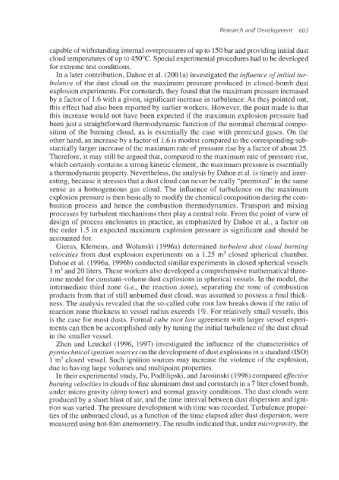Page 636 - Dust Explosions in the Process Industries
P. 636
Research and Development 603
capable of withstanding internal overpressures of up to 150bar and providing initial dust
cloud temperatures of up to 450°C. Special experimental procedures had to be developed
for extreme test conditions.
In a later contribution, Dahoe et al. (2001a) investigated the influence of initial tur-
bulence of the dust cloud on the maximum pressure produced in closed-bomb dust
explosion experiments. For cornstarch, they found that the maximum pressure increased
by a factor of 9.6 with a given, significant increase in turbulence. As they pointed out,
this effect had also been reported by earlier workers. However, the point made is that
this increase would not have been expected if the maximum explosion pressure had
been just a straightforward thermodynamic function of the nominal chemical compo-
sition of the burning cloud, as is essentially the case with premixed gases. On the
other hand, an increase by a factor of 1.6 is modest compared to the corresponding sub-
stantially larger increase of the maximum rate of pressure rise by a factor of about 25.
Therefore, it may still be argued that, compared to the maximum rate of pressure rise,
which certainly contains a strong kinetic element, the maximum pressure is essentially
a thermodynamic property. Nevertheless, the analysis by Dahoe et al. is timely and inter-
esting, because it stresses that a dust cloud can never be really “premixed” in the same
sense as a homogeneous gas cloud. The influence of turbulence on the maximum
explosion pressure is then basically to modify the chemical composition during the com-
bustion process and hence the combustion thermodynamics. Transport and mixing
processes by turbulent mechanisms then play a central role. From the point of view of
design of process enclosures in practice, as emphasized by Dahoe et al., a factor on
the order 1.5 in expected maximum explosion pressure is significant and should be
accounted for.
Gieras, Klemens, and Wolanski (1996a) determined turbulent dust cloud burning
velocities from dust explosion experiments on a 1.25 m3 closed spherical chamber.
Dahoe et al. (1996a, 1996b) conducted similar experiments in closed spherical vessels
1m3 and 20 liters. These workers also developed a comprehensive mathematical three-
zone model for constant-volume dust explosions in spherical vessels. In the model, the
intermediate third zone (Le., the reaction zone), separating the zone of combustion
products from that of still unburned dust cloud, was assumed to possess a final thick-
ness. The analysis revealed that the so-called cube root law breaks down if the ratio of
reaction zone thickness to vessel radius exceeds 1%. For relatively small vessels, this
is the case for most dusts. Formal cube root law agreement with larger vessel experi-
ments can then be accomplished only by tuning the initial turbulence of the dust cloud
in the smaller vessel.
Zhen and Leuckel (1996, 1997) investigated the influence of the characteristics of
pyrotechnical ignition sources on the development of dust explosions in a standard (ISO)
1 m3 closed vessel. Such ignition sources may increase the violence of the explosion,
due to having large volumes and multipoint properties.
In their experimental study, Pu, Podfilipski, and Jarosinski (1998) compared efective
burning velocities in clouds of fine aluminum dust and cornstarch in a 7 liter closed bomb,
under micro gravity (drop tower) and normal gravity conditions. The dust clouds were
produced by a short blast of air, and the time interval between dust dispersion and igni-
tion was varied. The pressure development with time was recorded. Turbulence proper-
ties of the unburned cloud, as a function of the time elapsed after dust dispersion, were
measured using hot-film anemometry. The results indicated that, under micvogravity,the

